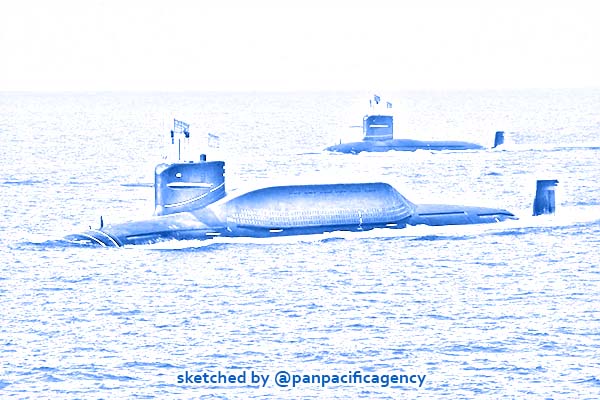[Analytics] New China, Russia sub project puzzles analysts

Two upgraded Type 094A nuclear submarines have gone into service in China. Photo: Reuters. Sketched by the Pan Pacific Agency.
Submarine technology is often shrouded in mystery, with details on rivals difficult, if not impossible to obtain. Like submarine warfare itself, finding information on new submarines is often a waiting game. Dave Makichuk specially for the Asia Times.
According to RIA Novosti, a state-controlled Russian news agency, Russia and China are collaborating on a secret new submarine design (in Russian). The project is being coordinated by Russia’s Federal Service for Military-Technical Cooperation.
But unlike the US Navy, both Russia and China continue to operate non-nuclear attack submarines in addition to nuclear ones. They are cheaper and have some advantages compared to nuclear boats, especially inshore. And they can be exported to other countries.
According to a report in Forbes magazine, Russia and China may pool their knowledge to develop a new generation of non-nuclear subs. But exactly what it will be, or why, is still a mystery.
According to National Interest, it is not the first time that Moscow and Beijing have linked hands.
China bought Russia’s very cutting-edge S-400 air defense system which is possibly the world’s most advanced. China has also imported Russia’s capable Sukhoi Su-35 fighter.
China continues to struggle manufacturing advanced airfare engine designs, and it was suspected that China hoped to copy both the Su-35 airframe and its advanced engines in order to give the domestic Chinese aerospace industry a leg up, much to Moscow’s consternation.
Meanwhile, Russia has a proud tradition of submarine building, creating many of the most powerful and largest subs in the world, so it’s not surprising that Russian submarine technology is seen as significantly ahead of China’s, Forbes reported.
Russia helped China develop its submarine building industry, giving it the plans to the Golf Class ballistic missile submarine and Romeo Class attack submarine during the Cold War. More recently Russia supplied China with Kilo Class diesel-electric attack submarines.
But China has gone its own way with submarine design and has the indigenous capability to build any category of sub.
And while there are still categories of submarine where Russia is clearly ahead, in the field of non-nuclear submarines it is less clear cut. Certainly China’s capabilities in this space should not be underestimated, Forbes reported.
One important area where China may be ahead is in propulsion. China is building AIP (Air Independent Power) submarines while Russia has struggled to field this technology, though it was a pioneer of AIP in the early stages of the Cold War.
Russia’s current Lada Class boat was expected to have AIP but it has yet to be fitted. Given Russia’s prowess in submarine design and construction the issue may be more about investment than engineering, Forbes reported.
But today it is fair to say that China is ahead in AIP.
Advanced batteries might be another space. Submarines are only now switching to lithium-ion batteries. The world’s first Li-ion subs were Japanese, with South Korean and Italian subs to follow.
China has also been rumored to be adopting this technology, making it another area where China might well be ahead of Russia, Forbes reported.
So have the roles reversed, and might Russia in effect be looking to buy a largely Chinese non-nuclear submarine?
Combining the hull technology of one nation with the combat systems and weapons of the other is another possibility. For example, giving a Chinese submarine Russian sonar and weapons, or fitting a Russian submarine with Chinese battery and AIP technology, Forbes reported.
While the People’s Liberation Army Navy is indeed interested in expanding their power projection capabilities farther and farther away from Chinese waters, a small attack submarine could be incredibly useful in the South China Sea in the not so distant future, National Interest reported.
The region’s shallow waters and relatively confined space would play well to small attack submarines that could be resupplied by Chinese-controlled islands.
Yet another possibility could be a submarine with Chinese guts and Russian teeth.
Russia’s submarine weapons are amongst the most advanced in the world and China would no doubt like to have access to Russian weapon designs, if not actual examples which could be reverse-engineered for Beijing’s own benefit.
Then again, it’s also possible the new submarine is not intended for the domestic navies of either country — both compete on the international market.
China is getting an ever bigger share of this market with sales to Thailand, Bangladesh and Pakistan.
In the end, the prospect of a joint non-nuclear submarine currently raises more questions than answers.